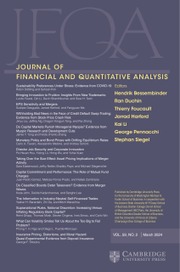Article contents
High-Frequency Trading Competition
Published online by Cambridge University Press: 19 September 2018
Abstract
Theory on high-frequency traders (HFTs) predicts that market liquidity for a security decreases in the number of HFTs trading the security. We test this prediction by studying a new Canadian stock exchange, Alpha, that experienced the entry of 11 HFTs over 4 years. We find that bid–ask spreads on Alpha converge to those at the Toronto Stock Exchange as more HFTs trade on Alpha. Effective and realized spreads for non-HFTs improve as HFTs enter the market. To explain the contrast with theory, which models the HFT as a price competitor, we provide evidence more consistent with HFTs fitting a quantity-competitor framework.
Information
- Type
- Research Article
- Information
- Journal of Financial and Quantitative Analysis , Volume 54 , Issue 4 , August 2019 , pp. 1469 - 1497
- Copyright
- Copyright © Michael G. Foster School of Business, University of Washington 2018
Footnotes
We are grateful to Michael Brolley, David Cimon, Jennifer Conrad (the editor), Thierry Foucault, Bjorn Hagströmer, Terry Hendershott, Oleksiy Kryvstov, Albert Menkveld, Pamela Moulton, Christopher Parsons, Talis Putnins, Ryan Riordan, Gideon Saar, Mehrdad Samadi (the referee), and Joshua Slive for their many suggestions to improve the article; to seminar participants at the Canadian Economic Association, Canadian Imperial Bank of Commerce, Financial Risks International Forum, Ontario Securities Commission, Society for Financial Studies (SFS) Cavalcade, Stockholm Business School, Vienna High-Frequency Trading (HFT): Curse or Blessing, and the Western Financial Association; and to Adrian Eng and Faith Chin for their research assistance. This article is an extension of the Bank of Canada working paper by the same name. The views expressed in this paper are those of the authors. No responsibility for them should be attributed to the Bank of Canada. All errors are our own.
References
- 74
- Cited by

